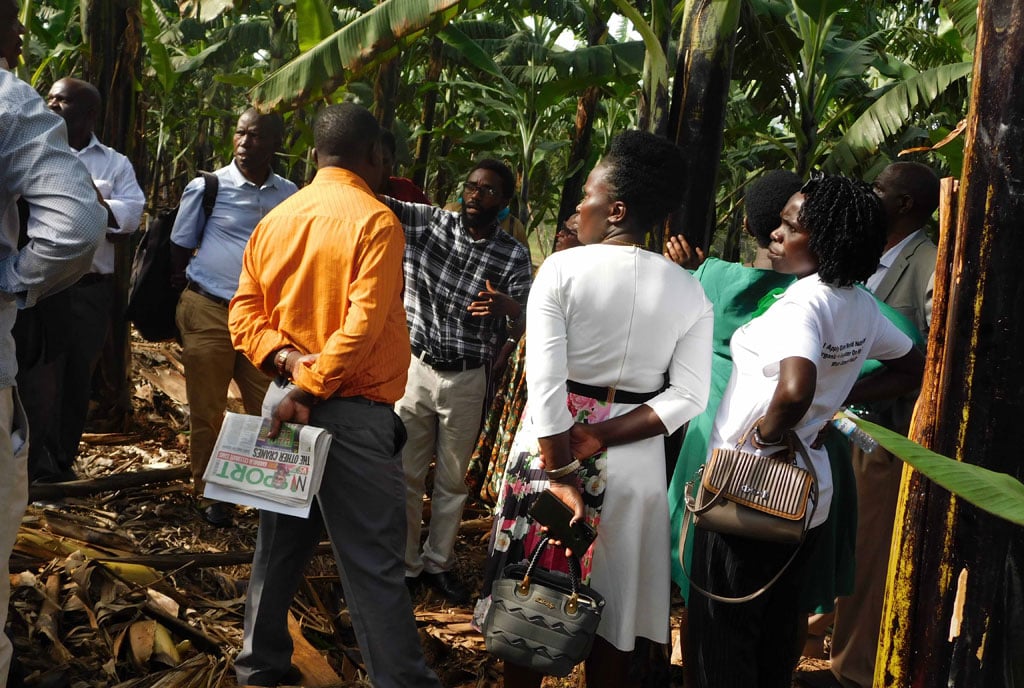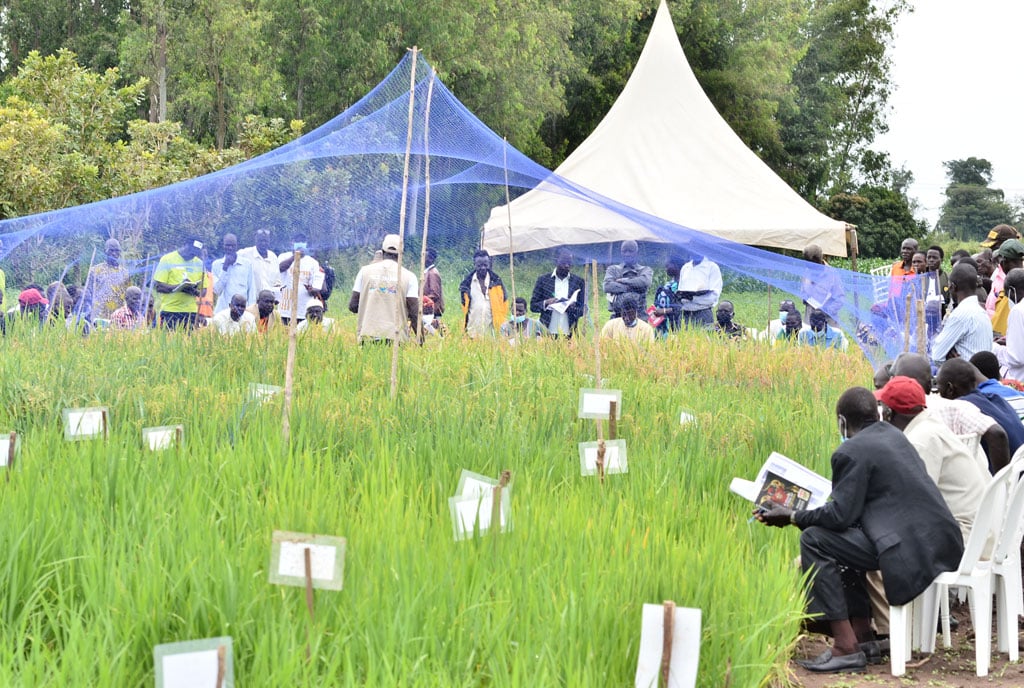Ugandan farming story of 60 years

Agricultural Services Extension Officers in Mbarara learn about the Banana Bacterial Disease. PHOTO/MICHEAL J SSALI
What you need to know:
- Climate change has come along with incurable crop diseases and insurmountable pests and our main cash and food crops are facing extinction unless some solutions are quickly found.
When Uganda became independent in 1962, the country’s population was about six million. The population density was low and there was plenty of free space on which to carry out agriculture.
The natural forests and wetland were almost intact. There were hardly any complaints about environment degradation.
In most cases the size of the economic activity in a given area is related to the number of people living there. Farming was the dominant economic activity in almost all parts of Uganda.
Farming land
There was always virgin land on which to grow crops and agriculture was more organic than it is today when the tendency to fight weeds and pests is to use agricultural chemicals.
There was hardly any caution about the challenges of sustaining large families and the population grew very fast today standing at about 44 million. There is widespread wrangling over land ownership now because there are far more people struggling for farming space than what is available.
In the industrial countries, where agricultural production is actually far higher, there are less people engaged in farming. For example, less than five percent of the population in the UK does farming.
They have large farms and use heavy machines such as tractors and combine harvesters to produce large amounts of food.
Backbone
In Uganda about 70 percent of the population is practising agriculture yet our agricultural production is quite inferior. We generally work on small, overworked, plots of land using simple tools such as hand hoes and pangas with limited capacity to use fertilisers and to do irrigation.
With the rapid population growth since independence more people have taken up farming as their main economic activity resulting in land fragmentation.
When the head of a household dies, our traditional inheritance rules dictate that the deceased’s property including land is divided up and shared among the children. Each settles on the smaller pieces of land where they start families and go on to produce more children who will later further subdivide the inherited plots of land.
Challenges
One of the main challenges facing agriculture today in Uganda is land fragmentation. Most of our farmers are stuck in small-scale production and cannot take advantage of large machines.
They do not earn enough profit to purchase fertilisers although it is obvious that the soil is overworked and depleted. Population pressure has forced people to carry out agriculture in areas previously reserved for wild life such as natural forests and wetlands.
Food production hardly matches consumption and food prices have sky-rocketed. Moses Muwonge, a small scale banana grower at Manja Village, Kisekka Sub-county, in Lwengo District, has asked Seeds of Gold, “These days I sell a large bunch of banana at Shs25,000 to the traders; how much do they sell it in Kampala?”
Climate change
In 1962 only a few people in academic circles were aware of the then looming threat of climate change.
Today climate change is already upon us and its effects are real. We are experiencing severe droughts and devastating floods, both of which do not promote farming.
Climate change has come along with incurable crop diseases and insurmountable pests and our main cash and food crops are facing extinction unless some solutions are quickly found. For example, Robusta coffee is under attack by the Black Coffee Twig Borer, (BCTB) a destructive pest that hit the country in 1993 and is proving impossible to eradicate.
Crop diseases
Around the same time the destructive Coffee Wilt Disease struck, and caused untold loss to farmers. Banana Bacterial Wilt (BBW) is steadily wiping out entire banana plantations.
Cassava Brown Streak Disease is killing off cassava. Sweet potato for which Uganda is famous as the biggest producer in Africa is also being wiped out by the sweet potato weevil. Irish potatoes too are under attack by late blight causing up to 60 percent yield loss to farmers, according to Naro. Maize is under attack by the stem borer.
Augustine Kasumba, retired Agricultural Extension Services Officer, in Kisekka Sub-county has told Seeds of Gold, “The Ugandan farmer today has bigger challenges than the farmer of the early 1960s. Back then the diseases such as Coffee Wilt Disease which has wiped out nearly half of the crop were unknown. We are now dealing with more complicated crop diseases than the ones we were used to,” he says.
The pests and diseases certainly hamper agricultural production, increase hunger and malnutrition, apart from rising food prices. Yet our population increase rate is among the highest in the world, at the fertility rate of 5.6 children per woman, according to the Washington based Population Reference Bureau.
Overcoming some of the diseases and pests requires a lot of scientific research since so far there is no known chemical cure. Biotechnological research has been used to come up with solutions to some of the pests and diseases.
However, it has surprisingly taken Ugandan policy makers too long to appreciate the benefits of biotechnology and to come up with the required regulation to guide the growing of crop varieties discovered to be resistant to the pests and diseases.
Other African countries such as Kenya, Ethiopia, Nigeria, Sudan, Ghana, South Africa, and Egypt among many others have decided to adopt Biotechnology as a tool to increase agricultural production in the face of Climate Change. Last year Kenya approved the growing of Bt cotton to give new life to its fabrics and apparel industry. A few weeks ago Kenya approved full blown growing of GM crops so as to mitigate pest infestation and to reduce the use of pesticides.
Positive changes
However, there are some positive changes in farming that have taken place in Uganda.
Around the time of independence, the government controlled the prices of cash crops such as coffee, cotton and produce which were sold to marketing boards including Coffee Marketing Board, Lint Marketing Board and Produce Marketing Board.
Gerald Ssendaula, former Minister of Finance, has told Seeds of Gold, “We have to thank the NRM for liberalising the coffee trade. Coffee prices were always determined by the government but today farmers individually or as groups decide who to sell their crop to after being satisfied that the price is right.
Farmers are earning more from the crop today than in the past.” Another attribute Ssendaula gives to the NRM government is the increased awareness of value addition among farmers. For example he welcomes Museveni’s effort for Uganda to sell soluble coffee instead of exporting coffee beans.
Diseases
Sweet potato for which Uganda is famous as the biggest producer in Africa is also being wiped out by the sweet potato weevil.
Irish potatoes too are under attack by late blight causing up to 60 percent yield loss to farmers, according to Naro. Maize is under attack by the stem borer.




